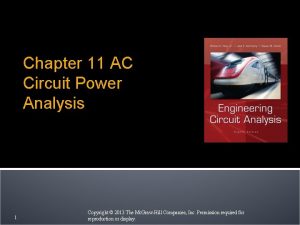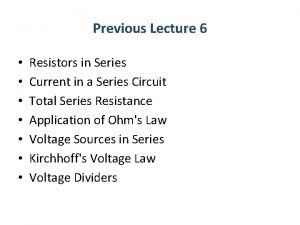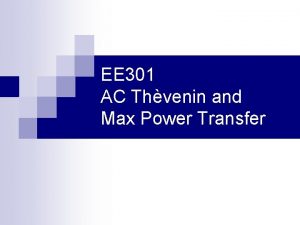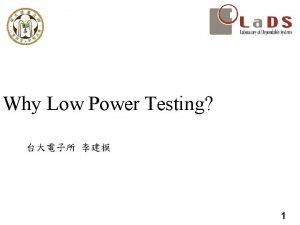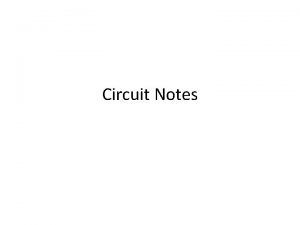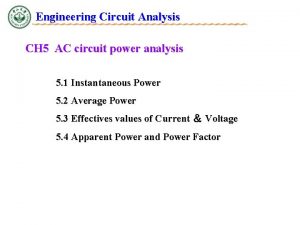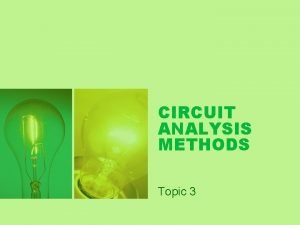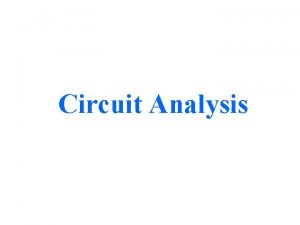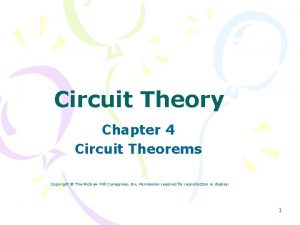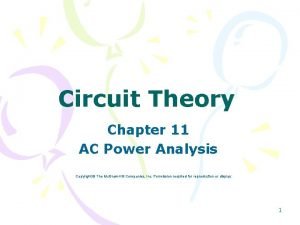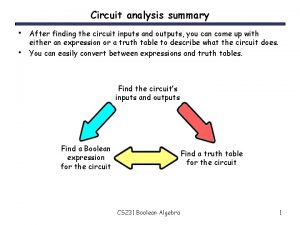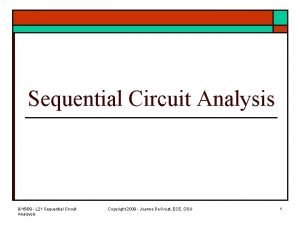Chapter 11 AC Circuit Power Analysis 1 Copyright




















- Slides: 20

Chapter 11 AC Circuit Power Analysis 1 Copyright © 2013 The Mc. Graw-Hill Companies, Inc. Permission required for reproduction or display.

Instantaneous Power The instantaneous power is p(t)=v(t)i(t). At all times t, power supplied = power absorbed Copyright © 2013 The Mc. Graw-Hill Companies, Inc. Permission required for reproduction or display. 2

Power from Sinusoidal Source If in the same RL circuit, the source is Vmcos(ωt), then and so the power will be Double Frequency Term Constant Term Copyright © 2013 The Mc. Graw-Hill Companies, Inc. Permission required for reproduction or display. 3

Average Power The average power over an arbitrary interval from t 1 to t 2 is When the power is periodic with period T, the average power is calculated over any one period: Copyright © 2013 The Mc. Graw-Hill Companies, Inc. Permission required for reproduction or display. 4

Average Power: Sinusoidal Steady State If v(t)=Vmcos(ωt+θ) and i(t)=Imcos(ωt+ϕ), then Copyright © 2013 The Mc. Graw-Hill Companies, Inc. Permission required for reproduction or display. 5

Average Power for Elements The average power absorbed by a resistor R is The average power absorbed by a purely reactive element(s) is zero, since the current and voltage are 90 degrees out of phase: Copyright © 2013 The Mc. Graw-Hill Companies, Inc. Permission required for reproduction or display. 6

Example: Average Power Find the average power absorbed by each element. Answer: PL=0 W Pleft=-50 W PC=0 W, PR=25 W Pright=25 W Copyright © 2013 The Mc. Graw-Hill Companies, Inc. Permission required for reproduction or display. 7

Maximum Power Transfer An independent voltage source in series with an impedance Zth delivers a maximum average power to that load impedance ZL which is the conjugate of Zth: ZL = Zth* Copyright © 2013 The Mc. Graw-Hill Companies, Inc. Permission required for reproduction or display. 8

Maximum Power Transfer Derivation First, solve for the load power: Clearly, P is largest when XL+Xth=0 Solving d. P/d. RL=0 will show that RL=Rth Copyright © 2013 The Mc. Graw-Hill Companies, Inc. Permission required for reproduction or display. 9

Effective Values of Current and Voltage The same power is delivered to the resistor in the circuits shown. periodic, period T Copyright © 2013 The Mc. Graw-Hill Companies, Inc. Permission required for reproduction or display. 10

Effective (RMS) for Sine Wave The effective value is often referred to as the root-mean-square or RMS value. For sine waves: Power is now Copyright © 2013 The Mc. Graw-Hill Companies, Inc. Permission required for reproduction or display. 11

Apparent Power & Power Factor If v(t)=Vmcos(ωt+θ) and i(t)=Imcos(ωt+ϕ), then the apparent power is defined as Veff. Ieff and is given the units volt-ampere V A Copyright © 2013 The Mc. Graw-Hill Companies, Inc. Permission required for reproduction or display. 12

Example: Average Power Find the average power being delivered to an impedance ZL= 8 − j 11 Ω by a current I= 5 ej 20° A. Only the 8 -Ω resistance enters the average-power calculation, since the j 11 -Ω component will not absorb any average power. Thus, P = (1/2)(52)8 = 100 W Copyright © 2013 The Mc. Graw-Hill Companies, Inc. Permission required for reproduction or display. 13

Apparent Power & Power Factor Power factor is defined as for a resistive load, PF=1 for a purely reactive load, PF=0 generally, 0 ≤ PF ≤ 1 Copyright © 2013 The Mc. Graw-Hill Companies, Inc. Permission required for reproduction or display. 14

Power Factor: Lagging & Leading Since the power factor for sine waves is the information as to whether current leads or lags voltage is lost, so we add the adjective to the power factor term. An inductive load has a lagging PF. A capacitive load has a leading PF. Copyright © 2013 The Mc. Graw-Hill Companies, Inc. Permission required for reproduction or display. 15

Example: Power Factor Find the average power delivered to each of the two loads, the apparent power supplied by the source, and the power factor of the combined loads. Answer: 288 W, 144 W, 720 VA, PF=0. 6 (lagging) Copyright © 2013 The Mc. Graw-Hill Companies, Inc. Permission required for reproduction or display. 16

Complex Power Define the complex power S as the real part of S is P, the average power the imaginary part of S is Q, the reactive power, which represents the flow of energy back and forth from the source (utility company) to the inductors and capacitors of the load (customer) Copyright © 2013 The Mc. Graw-Hill Companies, Inc. Permission required for reproduction or display. 17

Complex Power Splitting the current phasor Ieff into in-phase and out-of-phase components is another way of visualizing the complex power. Copyright © 2013 The Mc. Graw-Hill Companies, Inc. Permission required for reproduction or display. 18

Complex Power Complex powers to loads add: Copyright © 2013 The Mc. Graw-Hill Companies, Inc. Permission required for reproduction or display. 19

Example: Power Factor Correction An industrial consumer is operating a 50 k. W induction motor at a lagging PF of 0. 8. The source voltage is 230 V rms. In order to obtain lower electrical rates, the customer wishes to raise the PF to 0. 95 lagging. Specify a suitable solution. Answer: deploy a capacitor in parallel with the motor, as shown above. At 60 Hz, C=1. 056 m. F Copyright © 2013 The Mc. Graw-Hill Companies, Inc. Permission required for reproduction or display. 20
 Real power formula
Real power formula Ac circuit power analysis
Ac circuit power analysis Series vs paralle
Series vs paralle Two types of circuits
Two types of circuits Parallel circuit circuit construction kit
Parallel circuit circuit construction kit Parallel circuit vs series circuit
Parallel circuit vs series circuit Complete circuit and incomplete circuit
Complete circuit and incomplete circuit Short circuit circuit diagram
Short circuit circuit diagram Formula for venn diagram with 3 circles
Formula for venn diagram with 3 circles Diagram of circulatory system
Diagram of circulatory system Current in a parallel circuit
Current in a parallel circuit Power in series circuit
Power in series circuit In purely resistive circuit, i &v are
In purely resistive circuit, i &v are Maximum power transfer theorem
Maximum power transfer theorem Ac dc power supply circuit
Ac dc power supply circuit Short circuit power
Short circuit power Solar power satellites and microwave power transmission
Solar power satellites and microwave power transmission Potential power
Potential power Flex power power supply
Flex power power supply Dispersive power of grating equation
Dispersive power of grating equation Power of a power property
Power of a power property

